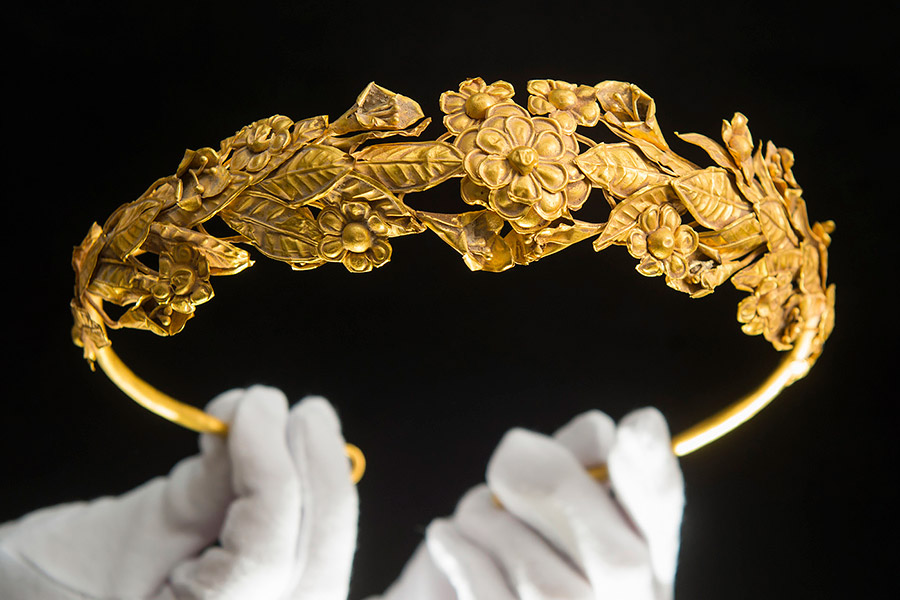Unlocking the secrets of ancient civilizations has always been a captivating endeavor. From towering monuments to intricate artwork, each artifact holds a story waiting to be discovered. And when it comes to ancient Greek culture, one area that shines brightly is their dazzling array of jewellery. These exquisite pieces not only showcase the extraordinary craftsmanship of the time but also provide insights into their myths and beliefs. So, grab your magnifying glass and join us on an enchanting journey through time as we explore what ancient Greek jewellery reveals about their gods and myths! Prepare to be amazed by the hidden tales behind these shimmering cultural treasures. Let’s dive in!
What is Ancient Greek Jewellery?
Step into the world of ancient Greek jewellery, and you will be transported to a realm where beauty intertwines with mythology. These precious adornments were more than just fashion statements; they held deep cultural significance. Ancient Greek jewellery encompassed a wide variety of pieces, ranging from necklaces and bracelets to rings and earrings.
Crafted with intricate details, these treasures featured motifs inspired by nature, gods, and mythical creatures. The materials used included gold, silver, gemstones like amethysts and emeralds, as well as more humble materials such as bone or clay for less affluent individuals.
One remarkable aspect of ancient Greek jewellery is its versatility – it was worn by both men and women across all social classes. It wasn’t just reserved for special occasions either; everyday wear also showcased their love for aesthetics.
Beyond mere ornamentation, these jewels served a deeper purpose: they symbolized protection from evil spirits or invoked blessings from the gods. They acted as talismans that connected the wearer to their beliefs and offered divine guidance in times of need.
Notably influential in shaping the design of ancient Greek jewellery were mythological tales featuring gods like Zeus, Aphrodite,and Apollo. Each deity had distinct characteristics associated with them which found expression through symbols incorporated into the designs. For example,crescent moons representing Artemis or laurel wreaths symbolizing victory linked to Nike,the goddess of triumph.
Intriguingly,pieces depicting Medusa heads were believed to have protective properties against harm,based on her power to turn enemies into stone with a single glance!
Ancient Greek jewellery not only represented artistry but also held immense cultural value within society.
The Different Gods and Myths
Ancient Greek mythology is a rich tapestry of gods, goddesses, and epic tales that has fascinated people for centuries. Each deity had their own unique qualities and powers, which were often depicted in the exquisite jewellery worn by ancient Greeks.
One of the most famous gods in Greek mythology is Zeus, the king of all gods. He was associated with thunder and lightning, symbolizing his immense power. To honor Zeus, ancient Greeks adorned themselves with jewelry featuring thunderbolts or eagles – both symbols of this mighty god.
Another prominent figure in Greek mythology is Aphrodite, the goddess of love and beauty. She was known for her irresistible charm and allure. Jewellery dedicated to Aphrodite often featured delicate details such as roses or doves – symbols of love and femininity.
Poseidon, the god of the sea, also held great significance in Ancient Greek culture. His trident represented his control over water bodies. Jewellery inspired by Poseidon would incorporate seashells or waves to capture his domain.
Hermes was revered as the messenger god who bridged communication between humans and deities alike. His winged sandals became a popular motif in jewellery design during this time period.
These are just a few examples among countless others from Greek mythology where jewellery played an integral role in expressing devotion to various deities or immortalizing legendary stories.
The Meaning behind the Jewellery
Ancient Greek jewellery was much more than just decorative adornments. Each piece held deep symbolism and meaning, reflecting the beliefs, myths, and gods of this ancient civilization.
For the Greeks, their jewellery served as a way to honor their gods and goddesses. Each deity had specific symbols associated with them, which were often incorporated into the design of the jewellery. For example, a necklace might feature a pendant in the shape of a thunderbolt to represent Zeus, or an owl pendant for Athena.
Jewellery also played a role in storytelling. Many pieces depicted scenes from famous myths and legends. These wearable works of art allowed people to carry these stories with them wherever they went.
Beyond religious significance, Greek jewellery also conveyed social status and wealth. The materials used in creating these intricate pieces varied depending on one’s standing in society. Gold was reserved for those at the top while silver or bronze were more common among everyday people.
Additionally,en it came to marriage customs,some pieces symbolized love and union – such as wedding rings shaped like intertwined snakes representing eternal love-while others served as protective talismans against evil spirits or ill-fortune.
Overall,Ancient Greek jewellery carried significant meaning beyond mere ornamentation.
It not only reflected religious beliefs but also demonstrated social status,told stories,and even brought luck and protection.
These exquisite creations have left us with a rich legacy that continues to captivate our imaginations today
How the Jewellery was Made
Ancient Greek jewellery was not only admired for its exquisite designs and intricate details but also for the skill and craftsmanship involved in its creation. The process of making these beautiful pieces of art was a laborious one, requiring immense patience and precision.
The artisans would carefully select the materials they wanted to work with. They commonly used precious metals like gold and silver, as well as gemstones such as amethysts, pearls, and emeralds. These materials were not only valued for their beauty but also held symbolic significance in ancient Greek mythology.
Once the materials were gathered, the artisans would begin shaping them into various forms using tools like hammers, chisels, and files. This meticulous process involved carving intricate patterns or symbols onto metal surfaces or setting gemstones into delicate settings.
Next came the polishing stage where the jewellery piece would be refined until it achieved a smooth and shiny finish. This step required great attention to detail to ensure that every surface reflected light perfectly.
Additional embellishments such as enamel or filigree work might be added to enhance the overall aesthetic appeal of the piece. These decorative elements served to further showcase both creativity and mastery of technique.
The Different Styles of Jewellery
The ancient Greeks were known for their exquisite taste in jewelry, and they had a wide variety of styles that reflected their beliefs and traditions. One popular style was the pendant necklace, which often featured a charm or amulet depicting a god or goddess. These pendants were believed to bring protection and good fortune to the wearer.
Another common style of Greek jewelry was the bracelet, which could be made from various materials such as gold, silver, or even bone. These bracelets often featured intricate designs such as geometric patterns or symbols representing gods and mythical creatures.
Earrings were also a popular accessory among the ancient Greeks. They would wear elaborate earrings that varied in size and shape, with some featuring detailed engravings of gods or mythical beings. Earrings were not only worn by women but also by men as a symbol of status and wealth.
Rings held special significance in Greek culture, particularly signet rings that bore engraved images or symbols representing an individual’s family heritage or social status. These rings were used for sealing documents and letters.
Hair ornaments were another important aspect of Greek jewelry. Women would adorn their hair with beautiful tiaras made from precious metals adorned with gemstones like diamonds, emeralds, sapphires, and pearls.
The different styles of Ancient Greek jewellery provide us with insights into their rich cultural traditions and religious beliefs. Each piece tells its own story through its design and symbolism – whether it’s showcasing powerful deities like Athena or Aphrodite or depicting mythological creatures like centaurs and griffins.
Ancient Greek jewellery truly captures the essence of this fascinating civilization – its myths, legends,and reverence for gods – all beautifully crafted into wearable works of art! So next time you see someone wearing a pendant necklace resembling Zeus thunderbolt o
Conclusion
Ancient Greek jewellery offers us a fascinating glimpse into the world of gods and myths that were central to their culture. These intricate pieces not only served as adornments but also held deep symbolic meanings.
Through the depictions of various gods and mythical figures, Culturize can understand the importance placed on religion and mythology in ancient Greece. Each piece tells a story or represents a particular deity, allowing us to connect with their beliefs and traditions.
The craftsmanship involved in creating these jewels is truly remarkable. From carving intricate designs into precious metals like gold and silver to incorporating vibrant gemstones, every detail was meticulously crafted by skilled artisans.
Furthermore, the different styles of jewellery reflect the evolving trends over time. From simple designs during the Archaic period to more elaborate pieces during Hellenistic times, Greek jewellery showcases artistic innovation throughout history.
Ancient Greek jewellery continues to captivate us today with its timeless beauty and rich cultural significance. By studying these artefacts, we gain valuable insights into an ancient civilization’s religious practices, mythological tales, and artistic achievements.
So next time you come across an exquisite piece of ancient Greek jewellery in a museum or gallery exhibit, take a moment to appreciate not just its aesthetic appeal but also the stories it carries from a distant past – stories that speak volumes about their gods and myths.


